The Intel Haswell-E CPU Review: Core i7-5960X, i7-5930K and i7-5820K Tested
by Ian Cutress on August 29, 2014 12:00 PM ESTIntel Haswell-E Overclocking
One of the burgeoning questions relating to overclocking over the past couple of years has been the quality of Intel’s construction under the heatspreader relating to thermal interface material and adhesives. This caused enough of a talking point for Intel to release Devil’s Canyon (read our review here) which featured an upgraded interface and essentially reduced the thermal pressure restricting the overclock.
Thankfully Intel has not decided to play around with the extreme edition platform too much since Nehalem. Although recent reports suggest that Intel is using an epoxy to bind the die to the heatspreader, one tell-tale sign that a goopy TIM is not being used is the hole in the heatspreader in one of the corners.
Looking through the previous generations, Sandy-E, Ivy-E and Haswell-E shows this hole, which is typically thought to allow for expansion of the heatspreader and/or gas trapped inside due to the heat. Also due to the way that the epoxy is handled, the heatspreader cannot be removed without force and destroying parts the silicon die.
Due to the way that the CPU is arranged, with the cores to the left and right of center, there may develop a series of recommendations when using different methods of applying thermal paste as the sources of the heat will most likely be in these two regions. I would advise the normal procedure of applying thermal paste here: a small blob in the middle and allow the heatsink to spread the TIM through applied pressure. This helps remove air bubbles as the TIM spreads; spreading it out manually leads to air bubbles all over the place and is not recommended for high thermal sources.
In our results below we are using a Cooler Master Nepton 140XL closed loop liquid CPU cooler, and following the instructions above our CPU temperatures stay extremely low until we pile on the overclock. In fact I was seeing less than 30ºC while idle, which should bode well for overclocking.
Methodology
Our standard overclocking methodology is as follows. We select the overclock options and test for stability with PovRay and OCCT to simulate high-end workloads. These stability tests aim to catch any immediate causes for memory or CPU errors.
For manual overclocks, based on the information gathered from stock testing, we start at a nominal voltage and CPU multiplier, and the multiplier is increased until the stability tests are failed. The CPU voltage is increased gradually until the stability tests are passed, and the process repeated until the motherboard reduces the multiplier automatically (due to safety protocol) or the CPU temperature reaches a stupidly high level (100ºC+). Our test bed is not in a case, which should push overclocks higher with fresher (cooler) air.
Results
Due to the timing of our testing, we were only able to test two i7-5960X CPUs. Both of these were M0 stepping samples, the same as the retail stepping as far as we understand. The i7-5960X for reference is a 3.0 GHz base clock CPU with 8 cores, with a stock load voltage around 1.050 volts. Standard turbo modes allow 3.5 GHz, and so we start our testing at 3.5 GHz on all cores at 1.000 volts set in the BIOS. Where load line calibration was possible, it was enabled to match our setting as closely as possible, but otherwise only the CPU voltage was adjusted.
The first sample has a lot of early headroom with +0.100 volts allowing for an extra +1.1 GHz, or a 36.7% overclock. It has been a long while since numbers like +36.7% has been bandied around Intel’s extreme range, with only the i7-920 type Nehalem CPUs doing that sort of overclock in its stride.
The sweet spot for this CPU seems to be at around 4.4 GHz where the CPU voltage is just starting to rise but peak temperatures are under 75ºC.
Unfortunately our second sample was pretty much a dud by comparison. The voltage needed early on in the overclock went up quickly. This time we were unable to monitor temperatures due to a BIOS issue, but had a power meter on hand. We still managed a +1.1 GHz overclock easily enough, although +0.175 volts was required.
At 4.1 GHz, peak power is +104W over the system power draw at stock, with another 40W at 4.3 GHz. This shows that Haswell-E can be a power hog from even small overclocks, and thus users must have cooling to match. If we add the 140W TDP and the +140W more from the overclock (it would most likely be more than this due to the change of efficiency in the PSU curve), then a mildly overclocked CPU is fast approaching 300W. One can imagine that a highly clocked 4.7 GHz sample would be nearer 400W, and thus users should purchase power supplies to match.
A Problem with Haswell
One issue from Haswell does crop up with Haswell-E: the variability in the quality of the processors. Intel only guarantees that the processor will run at the specific frequency and voltage that is applied out of the factory: any other speed is out of specification and not supported. With Haswell LGA1150 CPUs, while the turbo frequency of the i7-4770K was 3.9 GHz, some CPUs barely managed 4.2 GHz for a 24/7 system.
If we consider that the i7-4770K only needs one of those CPU cores to be below quality to ruin overclockability, then placing double the cores on the i7-5960X is asking for double the trouble. Time to put some numbers to this:
In ASUS’ press deck for overclocking recommendations that came with the X99-Deluxe, they tell us the following:
i7-5960X at 4.4 GHz with 1.300 volts is below average
i7-5960X at 4.5 GHz with 1.300 volts is average
i7-5960X at 4.6 GHz with 1.300 volts is above average
By that standard our first CPU is around average and the second CPU we tested is below average. Even with these guidelines, it would seem that other reviewers and even manufacturers are getting a wide array of results. I have heard of reports of CPUs getting 4.7 GHz on a water loop, whereas others are testing a range of CPUs and not getting more than 4.4 GHz, like our second sample.
ASUS is recommending that anything over 1.25 volts requires a water/liquid cooling as a bare minimum, with up to 1.35V needing a triple (3x120mm) radiator setup depending on ambient temperatures. As with most overclocked setups, this means that the enthusiast user must decide between clock speed or fan noise for their machine.
Another issue with Haswell-E is the current draw of the CPU. ASUS is stating that the standard current draw for the CPU can reach 25 amps, meaning that the power supply must be capable of supplying at least 30 amps on the EPS12V cable. This is covered for most home-build non-OEM power supplies with an 80 PLUS rating, but suggests that a cheap power supply might trigger the over-current protection early.
Comparison to Ivy Bridge-E, Sandy Bridge-E, Haswell
As part of our testing, we hooked up our older i7-4960X and i7-3960X to the ASUS Rampage IV Black Edition, as well as compared to our previous i7-4790K Haswell overclocks:
Our i7-3960X sample at the time was actually a really nice overclocking CPU, in comparison to our i7-4960X which was below overage. I put two values here for the i7-5960X, showing that a 4.3 GHz overclock, while it is lower in number than the 4.8 GHz of the i7-3960X, is actually around the same percentage overclock. If we have a good i7-5960X for comparison, then +50% overclock comes very easily.
The next question then is which one is better for performance? While the Haswell-E CPUs have a lower frequency than the previous generations, they do have the benefit of a higher IPC and DDR4 memory. There is also the core count, with the i7-5960X having 8 cores at 4.3/4.6 GHz against the six cores or four cores.
It should be obvious that for single core throughput, the i7-4790K wins at 4.7 GHz:
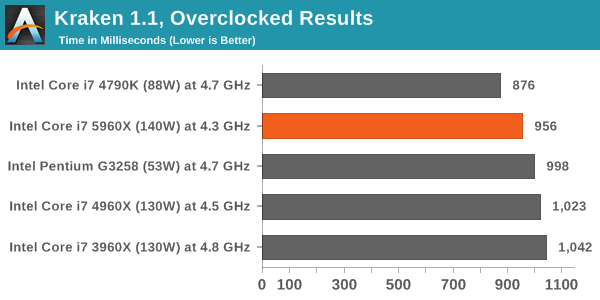
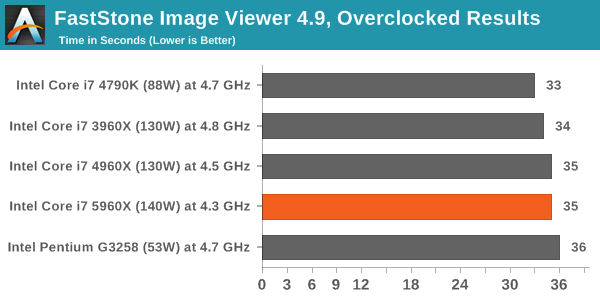
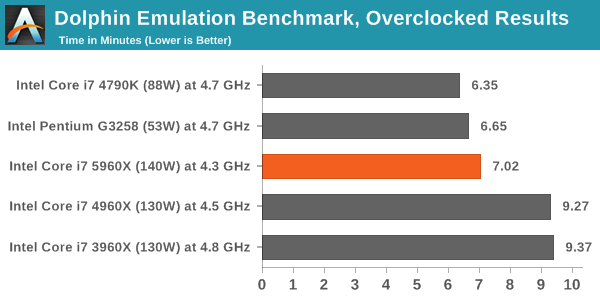
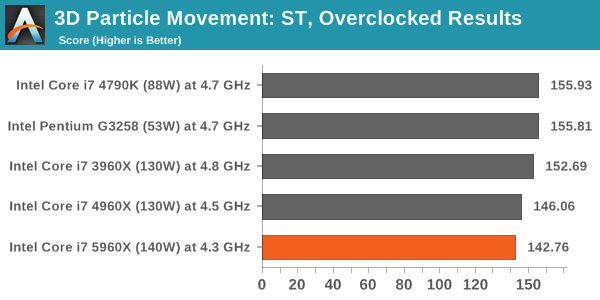
In most benchmarks, the 5960X, 4960X and 3960X are actually evenly matched for single threaded performance, with the 5960X taking the edge on software that can take advantage of the newer instruction sets.
For multithreaded tasks, an overclocked i7-5960X is the only way to go:
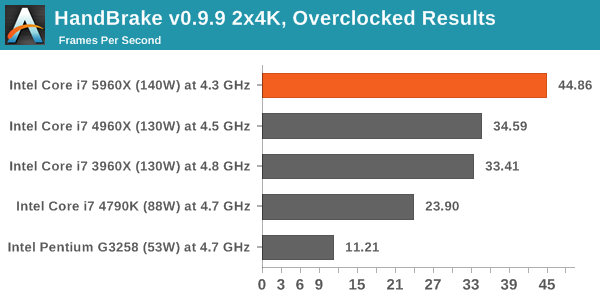
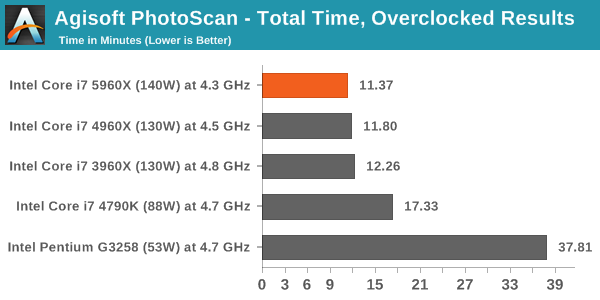
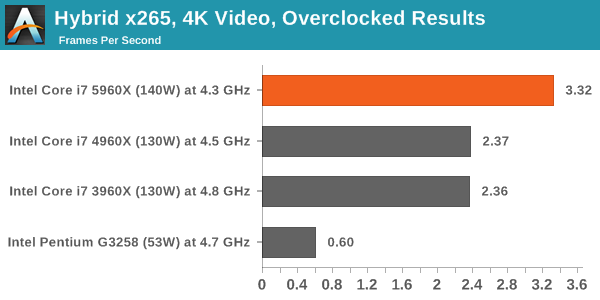
The graphs later in the review comparing each of these processors at stock will have our overclocked results as well.




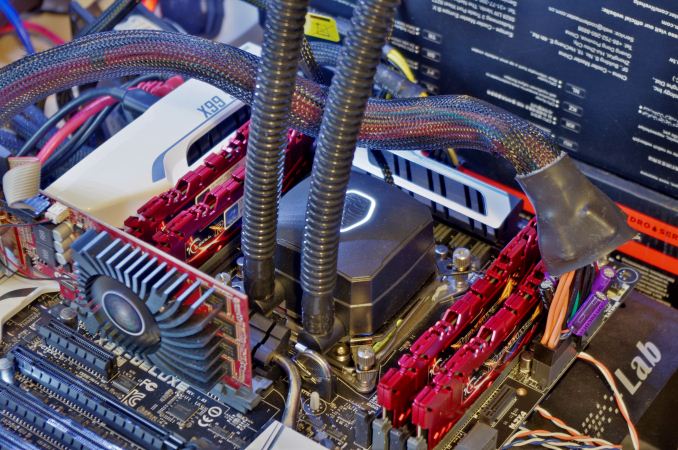
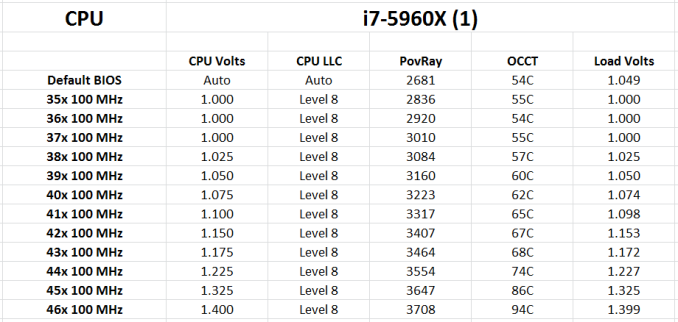
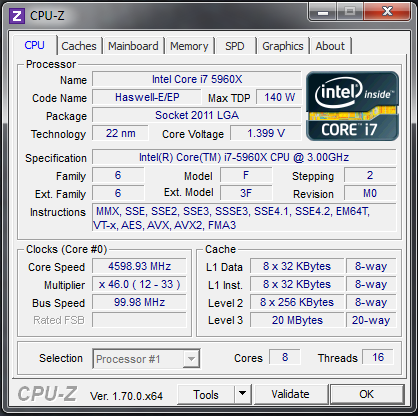
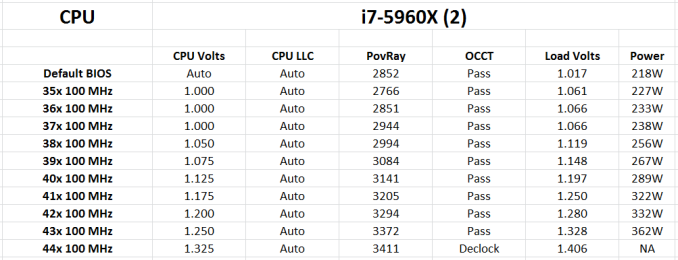










203 Comments
View All Comments
swing848 - Thursday, September 4, 2014 - link
Regarding your statement about game benchmarks, "It makes sense that we should test this with 4K in the future".You did not say how far into the future, in the near future it makes NO since. The video card you used was an 770; there is no way that GPU can handle 4K at high game settings, even medium settings will bring it to it's knees. First of all it is a mid-range GPU, secondly, it does not have enough local memory.
Lower resolutions more indicate what the CPU can do because the GPU is not overtaxed therefore not becoming a factor.
If you change anything, pick a higher end video card, to make sure the GPU is not bottlenecking tests.
M.Q.Leo - Saturday, September 6, 2014 - link
This generation has not much improvement I think. Especially 5820K, even less PCI-E Lanes there is! :(djemir - Monday, September 8, 2014 - link
I owned a first generation 2008 I7 running at a measly 2.7Ghz and I can tell you the new motherboard alone having 6GB/s SATA and 10GB/sec SATA interface made up for speed losses not to mention the 4790K running at 4.5GHz on a stable overclock. For photoshop and video the new CPU and motherboard have made a world of difference. Save time and open / read time has been reduced from 3-15 minutes per file down to "wait what I can count it on fingers???!" 7 seconds. That means no more "oh well it's saving let me go to the bathroom or something while I wait for this slow a$$ computer. I'm kind of wanting to kick myself for buying a z97 on the very day that the new x99's came out but when I did a price check it just wasn't worth it. This will hold me over til those crazy prices drop. I looked at bench marks for the 4790k vs the lower spectrum of the newer x99's and it looks like the 4790K does better in Photoshop than the X99 due to higher frequency. I even had to drop 8GB of Ram because my old motherboard had 6 slots and was holding 24GB of Ram in 4GB sticks now my new motherboard only has 4 slots. That made me sad. But even with less RAM the motherboard and processor are much more efficient and they can actually use the higher speeds of my SSDs and my 3GB/s and 6GB/s internal and external hard drives as well. Everyone arguing that their old processors are amazing need to open their eyes. On paper it all sounds like they are very much equal. But people forget that motherboards have been improving as well. I was having consistent blue screen crashes on my old system eve after refreshing the system a few times. This new configuration (Asus with i7-4790k) runs like a champ no blue screens at all, nothing but blue skies. I think Intel needs to just drop their prices a little, I would have prefered to get the 8 core i7 or 12 core xeon Yes that sucker is out there as well but at $1000-2500 for these units it's just not worth the small amounts of improvements vs the price. Whereas the huge increase i felt in performance at a much lower price point was worth the upgrade.untoreh - Friday, September 12, 2014 - link
What about benching some games that have decent multithreading? Like games on the bitsquid engine like War of the roses/war of the vikings? Or Natural Selection 2 with its immensive poligon count? No. Lets just benchmark GPU Heavy AAA titles that generally push the GPU Market more than the gaming market. If you wanna benchmark a 8 core CPU with games, you should AT LEAST let them be half with decent MT support.IUU - Thursday, September 18, 2014 - link
Well, except for gaming..Mostly true but not completely true.
If you play chess, the 8 core version will smoke any 4 core version just for fun.
There are other games that are not in the front scene right now that are mainly cpu demanding.
Any fps game currently in the market, is heavily based on showing realism, so it requires graphics processing power,and demanding from a powerful cpu to run such a game faster than the fractions of a second a slower cpu would, is well.. pointless.
But gaming is vast , bigger than your encoding software, your bitcoin mining, and your much advertised enterprise software. When developed further, it will require what the most demanding scientific applications require and probably more. See that it is already a main driving force(if not the main driving force) of modern supercomputer improvement. And it will be for the future.
Think of ingame ais, multiple ais, that will interact with the game world like a human would. Think of voice and pattern recognition, of tracking thousands or millions of objects, etc etc.
If your only aspiration in buying such a cpu is how good it will run current gen games, you wouldn't ever belong in the category of appropriate customers for this cpu. You would rather be excited by the mobile parts, which while anemic compared to the 8-core haswell, are fancy and fashionable and satisfy your vanity.
Of course it still remains as a problem, because of this sad market turn, the rise in the pricing of the "extreme" parts which puts the most of us off.
kelendar - Tuesday, September 23, 2014 - link
The one thing I like about the X99 chipset over my ASUS P8P67 Deluxe are the plethora of SATAIII ports and vastly improved onboard sound. The problem is the SB is a dead platform; there is no upgrade path with it and all boards ever made have few ports. I actually had to buy a separate add-in card but it suffers from being on the PCI-8x port - connect more than 1 drive, and they share the throughput.That's why I'm looking at this build. I figure the ASUS Rampage IV + 5820 + 16 GB RAM should set me back about $1,100 but it gives me a bit of future-proofing.
Spartan 363 - Wednesday, October 1, 2014 - link
I just purchased the i7 5930K along with an EVGA X99 Classified mobo with 16 GB of Corsair Dominator Platinum DDR4 3000 RAM for now along with 2 EVGA GTX 980 Classified for SLI. I purchased both the Classified versions of the mobo and GTX 980's because I love tinkering and overclocking to see what is the best stable clocks I can achieve without heating up my bedroom like my PC were a space heater which would be handy in a month or so as the cold weather returns to Northern VA where I live. My current PC and even my older PC that this build replaced are air cooled for now. I will buy WC blocked and such for my GTX 980's since I have fantastic components for overclocking with the Classified things from EVGA and a CPU that OC's well too on air.Sure,this was a very expensive upgrade, but at least the CPU, RAM and the MOBO will be good for the next 4-5 years just like my old aging i7 920 D0/MSI X58 Pro-E mobo w/12 GB of Corsair XMS3 DDR3 1600 Triple Channel and that PC had aging SLI GTX 680's that have been great so far, but it was time to upgrade that system, it was a great PC for all these years since I purchased it when the X58 and i7 series first launched back then.
This upgrade over my aging X58 build is a massive jump as I was running into CPU bottlenecks with my SLI GTX 680 even with the CPU overclocked to a stable 3.8GHZ on air cooling with good temps in mind. I tested my new system with both my old EVGA GTX 680 FTW+ 4GB cards in SLI and a single GTX 980 beats it in games that don;t have as great SLI/Crossfire support and when I placed my second GTX 980, it was overkill compared to the 680's but also using less power at the reference clocks at first. I may get a third GTX 980 but I'm holding out on the possible rumored GTX 980 Ti that may come around Spring 2015 and I hope to get 2 at least for SLI if they are a comparble upgrade like the GTX 780 Ti was over the 780 and I hope to have 6 to 8GB of VRAM on the cards too as I am gaming at 4K and there are times where the VRAM is topped out and more VRAM is needed. I'm just glad the that GTX 980 was such a great buy this time around and made a big difference for those of use on aging GTX 680's and earlier cards. I usually upgrade every 2 years for my GPU anyways. I am currently reading up and also overclocking my new build to to tutorials and such on these components that I have since it's been years since I really used to tinker with voltages, RAM memory timings and of course serious voltage tweaks to the GPUS for better overclocking. I actually miss the old days of my tinkeirng my PC for hours a day when I was younger, but at least I have the weekends off to tinker with my new gaming beast that should last me for a few more years. For now, I'm happy at the performance that I have with a mild overclock and my games run and look fantastic on my new 55 inch LG 55UB8500 4K TV that has HDMI 2.0 so that I can play at 60 FPS, but with my current setup,I'm averaging 40+ FPS in most games on ultra settings with AA set to 2 or non at all since in my opinion, a 55 inch 4K TV is the perfect size foe the resolution and turning off AA in most games makes no major difference in appearance on the screen due to the high resolution, so that's a major plus for 4K gaming and it's easier on the hardware too. That TV only cost me about $1500 in Best Buy during the Labor Day weekend sales. It was a steal for a TV that has great features and most importantly, HDMI 2.0 to take advantage of my GTX 980's in 4K instead of having to use Display Port to HDMI adapters I was using with my GTX 680 SLI to achieve 30+ FPS in a few games at 4K with no AA and such.
For those that want great performance at 4K, SLI GTX 980's are great and are great for systems that have PSUs typically that can comfortably handle both cards at load with a quality 750W PSU vs needing a 1000W unit for older cards.
Spartan 363 - Wednesday, October 1, 2014 - link
I forgot to mention that I am currently using 2 EVGA GTX 980 SC, but I will be sending them back next week to exchange them for the Classified cards that will be the aire cooled ones, but I am currently running clocks on both my current cards at a mild 1300 mhz OC on the core while the memory is at the factory clocks for now, not bad for air cooling, I know I can push for 1400 to 1500 but I will wait for the Classified cards for that type of OC as I will be getting EK WC blocks for both cards this time.sandwich_hlp - Tuesday, October 7, 2014 - link
Been trying to decipher Intel roadmaps and the like, to no avail, so... can anyone tell me approximately when the DDR4-supporting Core i5 line is expected to launch? I'm needing to upgrade my aged Core 2 Duo (DDR2!), but I don't wanna hop on the DDR3 bandwagon just as it's being superseded by DDR4... :-/GGuess - Saturday, December 6, 2014 - link
There should be a line of discussion of why haven't CPU speeds increased in the past 5years in a significant way. My 5yr old Intel I7 is a 4 core at 3GHz. The ones discussed here are only 6 or 8 cores and run stock in the mid-3 to 4GHz range. So over 5yrs, the CPU capability has not grown 2 to 3times faster, and that only applies to applications that can use the extra cores and hyper-threading. The usual rule we work to is that people won't even notice a 50% speed increase. It has to be 2 to 3 times before it is noticed. Previously, a 3year refresh of a computer resulted in a 5 to 10x computer speed increase.With the current barely noticeable 2x, why bother with the trouble of an upgrade? No wonder Intel's and AMD's sales figures are failing to grow.